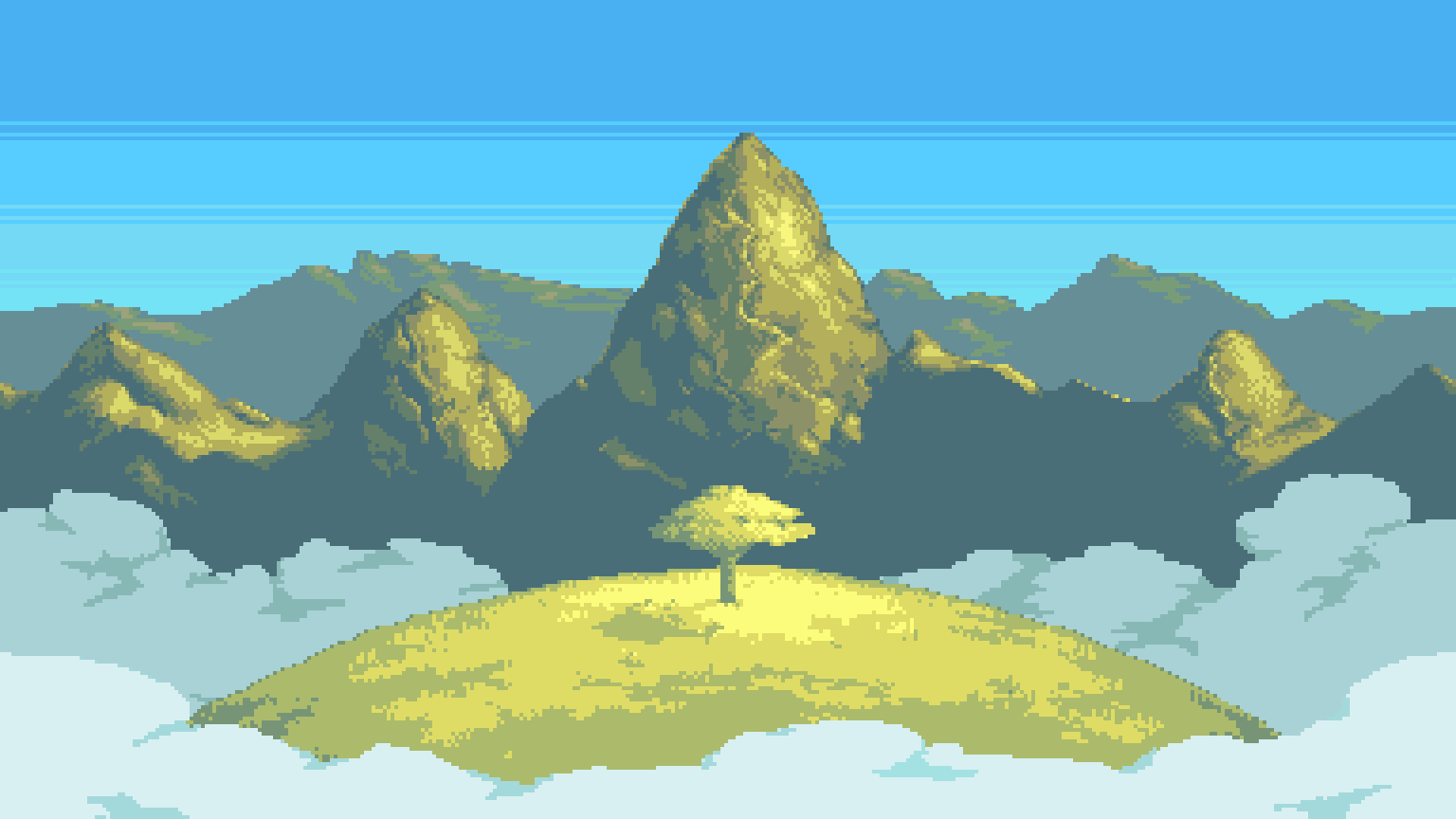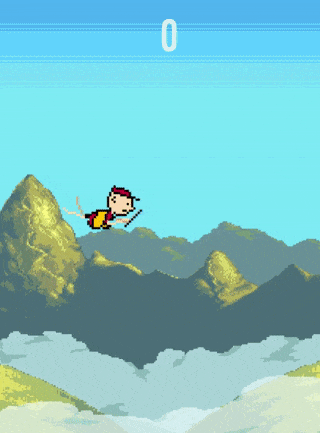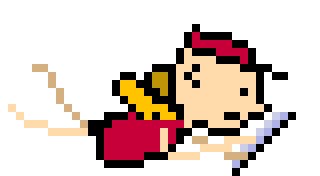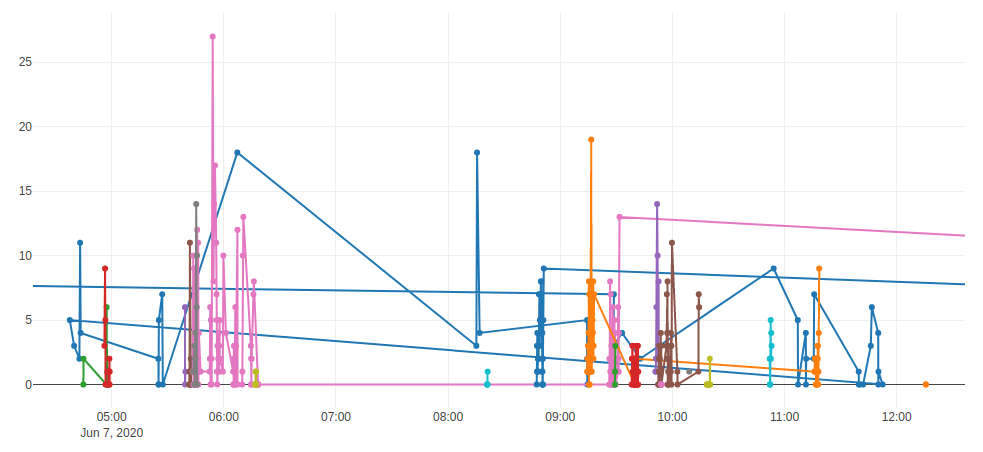Flappy Millennial: An HTML5 Canvas Game

Meet Flappy Millennial. He's an average guy in his mid 20's and the future looks bleak for him. With the threats of climate change, mass-extinctions, rising authoritarianism, economic depression, unprecedented wildfires and so much more ever-looming, nihilism has become his background music.
But worry not. For he has an antidote—well, not so much an antidote as a sedative. He has his phone! Come help this Flappy Millennial ignore reality while he scrolls through Instagram or something. You should play this game not because it's good or anything, but simply so you too can pretend that things are okay for a while.

Browse the source code on GitHub at niravcodes/flappy-millennial.
How it came to be
I began writing a different game for HTML5 canvas a month or so ago. As I was programming the game, I realised that a lot of my code was game agnostic. The abstractions and modules that had organically emerged could be packaged up and used to make other games. So I separated the game logic from the lower level management code, and lo! I had created my first game engine essentially as a side effect of refactoring.
Over time, I began to notice some problems with the design of the game engine API, and to investigate further, I asked some of my friends to try using it to make a game and report issues. But apparently they had their own work to do and "ain't nobody got time for fun and games, we're doing Serious Work". So like a neglected grandpa weaving his own straw mat while his granddaughters make TikTok videos, I began making Flappy Millennial.
But why another Flappy Bird clone?
Because I'm unoriginal.
But also because Flappy Bird has an engaging gameplay with a remarkably simple game mechanic. It's a child's play to write a clone and for some reason even the worst clones turn out to be fun. To prove the assertion I wrote yet another flappy bird clone right here. Turns out just 60 lines of code and about an hour or two is enough to make a fun flappy clone. Click the square below to focus the game.
Once you've played this to your heart's delight, check out the JavaScript it took to make it work:
<style>
#c:focus {
outline: dashed 4px #000;
}
</style>
<link
href="https://fonts.googleapis.com/css2?family=Poiret+One&display=swap"
rel="stylesheet"
/>
<canvas id="c" tabindex="1"></canvas>
<script>
let snd = new Audio(
"data:audio/wav;base64,//uQRAAAAWMSLwUIYAAsYkXgoQwAEaYLWfkWgAI0wWs/ItAAAGDgYtAgAyN+QWaAAihwMWm4G8QQRDiMcCBcH3Cc+CDv/7xA4Tvh9Rz/y8QADBwMWgQAZG/ILNAARQ4GLTcDeIIIhxGOBAuD7hOfBB3/94gcJ3w+o5/5eIAIAAAVwWgQAVQ2ORaIQwEMAJiDg95G4nQL7mQVWI6GwRcfsZAcsKkJvxgxEjzFUgfHoSQ9Qq7KNwqHwuB13MA4a1q/DmBrHgPcmjiGoh//EwC5nGPEmS4RcfkVKOhJf+WOgoxJclFz3kgn//dBA+ya1GhurNn8zb//9NNutNuhz31f////9vt///z+IdAEAAAK4LQIAKobHItEIYCGAExBwe8jcToF9zIKrEdDYIuP2MgOWFSE34wYiR5iqQPj0JIeoVdlG4VD4XA67mAcNa1fhzA1jwHuTRxDUQ//iYBczjHiTJcIuPyKlHQkv/LHQUYkuSi57yQT//uggfZNajQ3Vmz+Zt//+mm3Wm3Q576v////+32///5/EOgAAADVghQAAAAA//uQZAUAB1WI0PZugAAAAAoQwAAAEk3nRd2qAAAAACiDgAAAAAAABCqEEQRLCgwpBGMlJkIz8jKhGvj4k6jzRnqasNKIeoh5gI7BJaC1A1AoNBjJgbyApVS4IDlZgDU5WUAxEKDNmmALHzZp0Fkz1FMTmGFl1FMEyodIavcCAUHDWrKAIA4aa2oCgILEBupZgHvAhEBcZ6joQBxS76AgccrFlczBvKLC0QI2cBoCFvfTDAo7eoOQInqDPBtvrDEZBNYN5xwNwxQRfw8ZQ5wQVLvO8OYU+mHvFLlDh05Mdg7BT6YrRPpCBznMB2r//xKJjyyOh+cImr2/4doscwD6neZjuZR4AgAABYAAAABy1xcdQtxYBYYZdifkUDgzzXaXn98Z0oi9ILU5mBjFANmRwlVJ3/6jYDAmxaiDG3/6xjQQCCKkRb/6kg/wW+kSJ5//rLobkLSiKmqP/0ikJuDaSaSf/6JiLYLEYnW/+kXg1WRVJL/9EmQ1YZIsv/6Qzwy5qk7/+tEU0nkls3/zIUMPKNX/6yZLf+kFgAfgGyLFAUwY//uQZAUABcd5UiNPVXAAAApAAAAAE0VZQKw9ISAAACgAAAAAVQIygIElVrFkBS+Jhi+EAuu+lKAkYUEIsmEAEoMeDmCETMvfSHTGkF5RWH7kz/ESHWPAq/kcCRhqBtMdokPdM7vil7RG98A2sc7zO6ZvTdM7pmOUAZTnJW+NXxqmd41dqJ6mLTXxrPpnV8avaIf5SvL7pndPvPpndJR9Kuu8fePvuiuhorgWjp7Mf/PRjxcFCPDkW31srioCExivv9lcwKEaHsf/7ow2Fl1T/9RkXgEhYElAoCLFtMArxwivDJJ+bR1HTKJdlEoTELCIqgEwVGSQ+hIm0NbK8WXcTEI0UPoa2NbG4y2K00JEWbZavJXkYaqo9CRHS55FcZTjKEk3NKoCYUnSQ0rWxrZbFKbKIhOKPZe1cJKzZSaQrIyULHDZmV5K4xySsDRKWOruanGtjLJXFEmwaIbDLX0hIPBUQPVFVkQkDoUNfSoDgQGKPekoxeGzA4DUvnn4bxzcZrtJyipKfPNy5w+9lnXwgqsiyHNeSVpemw4bWb9psYeq//uQZBoABQt4yMVxYAIAAAkQoAAAHvYpL5m6AAgAACXDAAAAD59jblTirQe9upFsmZbpMudy7Lz1X1DYsxOOSWpfPqNX2WqktK0DMvuGwlbNj44TleLPQ+Gsfb+GOWOKJoIrWb3cIMeeON6lz2umTqMXV8Mj30yWPpjoSa9ujK8SyeJP5y5mOW1D6hvLepeveEAEDo0mgCRClOEgANv3B9a6fikgUSu/DmAMATrGx7nng5p5iimPNZsfQLYB2sDLIkzRKZOHGAaUyDcpFBSLG9MCQALgAIgQs2YunOszLSAyQYPVC2YdGGeHD2dTdJk1pAHGAWDjnkcLKFymS3RQZTInzySoBwMG0QueC3gMsCEYxUqlrcxK6k1LQQcsmyYeQPdC2YfuGPASCBkcVMQQqpVJshui1tkXQJQV0OXGAZMXSOEEBRirXbVRQW7ugq7IM7rPWSZyDlM3IuNEkxzCOJ0ny2ThNkyRai1b6ev//3dzNGzNb//4uAvHT5sURcZCFcuKLhOFs8mLAAEAt4UWAAIABAAAAAB4qbHo0tIjVkUU//uQZAwABfSFz3ZqQAAAAAngwAAAE1HjMp2qAAAAACZDgAAAD5UkTE1UgZEUExqYynN1qZvqIOREEFmBcJQkwdxiFtw0qEOkGYfRDifBui9MQg4QAHAqWtAWHoCxu1Yf4VfWLPIM2mHDFsbQEVGwyqQoQcwnfHeIkNt9YnkiaS1oizycqJrx4KOQjahZxWbcZgztj2c49nKmkId44S71j0c8eV9yDK6uPRzx5X18eDvjvQ6yKo9ZSS6l//8elePK/Lf//IInrOF/FvDoADYAGBMGb7FtErm5MXMlmPAJQVgWta7Zx2go+8xJ0UiCb8LHHdftWyLJE0QIAIsI+UbXu67dZMjmgDGCGl1H+vpF4NSDckSIkk7Vd+sxEhBQMRU8j/12UIRhzSaUdQ+rQU5kGeFxm+hb1oh6pWWmv3uvmReDl0UnvtapVaIzo1jZbf/pD6ElLqSX+rUmOQNpJFa/r+sa4e/pBlAABoAAAAA3CUgShLdGIxsY7AUABPRrgCABdDuQ5GC7DqPQCgbbJUAoRSUj+NIEig0YfyWUho1VBBBA//uQZB4ABZx5zfMakeAAAAmwAAAAF5F3P0w9GtAAACfAAAAAwLhMDmAYWMgVEG1U0FIGCBgXBXAtfMH10000EEEEEECUBYln03TTTdNBDZopopYvrTTdNa325mImNg3TTPV9q3pmY0xoO6bv3r00y+IDGid/9aaaZTGMuj9mpu9Mpio1dXrr5HERTZSmqU36A3CumzN/9Robv/Xx4v9ijkSRSNLQhAWumap82WRSBUqXStV/YcS+XVLnSS+WLDroqArFkMEsAS+eWmrUzrO0oEmE40RlMZ5+ODIkAyKAGUwZ3mVKmcamcJnMW26MRPgUw6j+LkhyHGVGYjSUUKNpuJUQoOIAyDvEyG8S5yfK6dhZc0Tx1KI/gviKL6qvvFs1+bWtaz58uUNnryq6kt5RzOCkPWlVqVX2a/EEBUdU1KrXLf40GoiiFXK///qpoiDXrOgqDR38JB0bw7SoL+ZB9o1RCkQjQ2CBYZKd/+VJxZRRZlqSkKiws0WFxUyCwsKiMy7hUVFhIaCrNQsKkTIsLivwKKigsj8XYlwt/WKi2N4d//uQRCSAAjURNIHpMZBGYiaQPSYyAAABLAAAAAAAACWAAAAApUF/Mg+0aohSIRobBAsMlO//Kk4soosy1JSFRYWaLC4qZBYWFRGZdwqKiwkNBVmoWFSJkWFxX4FFRQWR+LsS4W/rFRb/////////////////////////////////////////////////////////////////////////////////////////////////////////////////////////////////////////////////////////////////////////////////////////////////////////////////////////////////////////////////////////////////////////////////////////////////////////////////////////////////////////////////////////////////////////////////////////////////////////////////////////////////VEFHAAAAAAAAAAAAAAAAAAAAAAAAAAAAAAAAAAAAAAAAU291bmRib3kuZGUAAAAAAAAAAAAAAAAAAAAAAAAAAAAAAAAAAAAAAAAAAAAAAAAAAAAAAAAAAAAAAAAAMjAwNGh0dHA6Ly93d3cuc291bmRib3kuZGUAAAAAAAAAACU="
);
let pnt = (r = 0.2) => {
snd.playbackRate = r;
snd.play();
};
let C = document.querySelector("#c");
let W = (C.width = H = C.height = 350);
let CC = C.getContext("2d");
colH = S = P = 1;
let pipe1, pipe2;
{
let rH = () => (Math.random() * 100 + 50) | 0;
let pipe = (off) => {
let x = off,
h = rH();
return (rst) => {
if (rst) {
x = off;
colH = 0;
return;
}
if ((x = x - 2) < -50) {
x = W;
h = rH();
}
x > 70 && x < 100 ? (colH = h) : 0;
if (x == 20) {
colH = 0;
++S;
pnt(1);
}
CC.fillRect(x, 0, 50, h);
CC.fillRect(x, H, 50, h - H + 140);
};
};
pipe1 = pipe(W + 100);
pipe2 = pipe(W + 300);
}
let y = (h = w = 30);
(window.vy = 0), (ay = 0.4);
let LP = (window.onload = () => {
CC.fillStyle = "#235789";
CC.fillRect(0, 0, W, H);
if (P) {
pt("Press any key to play", H / 2);
pt("Score: " + S, H / 2 + 40);
pipe1(1);
pipe2(1);
return;
}
CC.fillStyle = "#f1d302";
y += vy += ay;
CC.fillRect(70, y, w, h);
if (colH && (y < colH || y + h > colH + 140)) {
y = 30;
P = 1;
pnt();
}
y > H + h ? (P = 1) & (vy = 0) & (y = 30) & pnt() : 0;
pipe1();
pipe2();
pt(S, 40);
requestAnimationFrame(LP);
});
CC.font = "24px 'Poiret One'";
var pt = (t, h) => {
CC.fillStyle = "#fff";
CC.fillText(t, (W - CC.measureText(t).width) / 2, h);
};
c.ontouchstart = c.onkeydown = (e) =>
P ? (P = 0) & (S = 1) & LP() : (vy = -8);
</script>
That's about 60 lines of javascript which makes a playable Flappy Bird game, complete with touch screen support and sound effects.
Now, that should have been the end of it. A game in 60 lines of code is good enough. But something in me was begging to take it even further. And as if to tempt me yet more, the power went out and with it the WiFi. What is a young man in this lockdown to do without the umbilical cord of the Internet forever pumping numbness into his thoughts?
So then I went ahead and made it even smaller.
<canvas id="c"/><script>C=document.querySelector('#c');W=C.width=H=C.height=350
colH=S=P=1;y=h=w=30;vy=0,ay=.4;for($ in CC=C.getContext('2d'))CC[$[0]+($[6]||'')]
=CC[$];rH=_=>Math.random()*99+50;pp=(off)=>{ let x=off,ph=rH();return r=>{r?(x=off)
&(colH=0):0;(x=x-2)<-50?(x=W)&(ph=rH()|0):0;(x>70&&x<100)?colH=ph:0;
x==20?(colH=0)&++S&B(400):0;CC.fc(x,0,50,ph);CC.fc(x,H,50,ph-H+140);}}
p1=pp(W+100);p2=pp(W+300);LP=onload=_=> {CC.fillStyle="#258";CC.fc(0,0,W,H)
if(P){pt("Score "+S,H/2);p1(1);p2(1);return};CC.fillStyle="#fd0"
y+=vy+=ay;CC.fc(70,y,w,h);colH&&(y<colH||y+h>colH+140)?(y=30)&
(P=1)&B():0;y>H+h?(P=1)&(vy=0)&(y=30)&(B()):0;p1();p2();pt(S,40);
requestAnimationFrame(LP)};CC.font="24px serif"
pt=(t,h)=>{CC.fillStyle="#fff";CC.fx(t,(W-CC.me(t).width)/2,h)}
c.ontouchstart=onkeydown=(e)=>P?(P=0)&(S=1)&LP():vy=-8;
A=new AudioContext;B=_=>{o=A.createOscillator();o.frequency.value=_||999
o.start();o.connect(A.destination);setTimeout(_=>o.stop(),99)}</script>
Yeah, that's right. It is 15 lines of handwritten HTML and javascript code that will make a flappy bird game in your browser. Pretty cool, huh? But line count is not a valid metric for this code. Here's a proper one: this code is less than 970 bytes. That's about a 100 times smaller than the code size of flappy millennial. And it still works! Of course, at that point I was left wondering why my actual Flappy Millennial code is so huge.
How?
The main game logic is
in the js/game.js file. It begins by importing a bunch of classes and
functions from the library, including Character, Spritesheet, Collider,
and StaticText. These classes abstract the mechanism of animating on the
canvas and checking for collisions among other things. These things are very
helpful because the canvas API, while flexible, is very low level. For example,
if you wanted to play an animation using the bare canvas API, you'd have to
convert your GIF into a sequence of images and manually draw each image while
also taking care of the timing and positioning. Things like that don't scale
well as the game gets bigger. With my library, you can simply say
Character.runAnimation() and the rest is taken care of for you. The game is
gradually implemented using these primitives and very simple javascript. A
casual skim of the code in js/game.js on GitHub should be enough to get most
implementation details.
I made most of the art for the game myself, including our titular character Flappy Millennial. It was made using Piskel which is a great pixel art animation software. It isn't as feature-rich as I'd like but works well right in the browser and I love it for that.

This is the animation for our Flappy Millennial. I labored over it for a couple of hours and I feel like it's turned out okay. But if I had to start again, I'd definitely make the wings not look so stiff and cardboard-like. The beautiful background art that I'm using was made by Vicente Nitti.
Build system
I've acquired the habit of writing ES6 javaScript by default because I do so much work with React, Vue and NodeJS. That's generally a good thing, but it also means that if I want my javascript code to work on most browsers, I'll have to use external tooling. That was the case with Flappy Millennial.
So I had to put together a set of tools to convert my modern javascript dialect to standard javascript understood by most browsers. Without this process, my code wouldn't work on current mobile browsers and slightly outdated or extended support editions of desktop browsers. It isn't a particularly difficult thing to do, because these tool makers have already put in all the effort.
First we pass our javascript through Babel with
plugins that convert to ES5 javascript. Then output is then passed to
Browserify, which reads all the imports and requires, and puts all the code
together in a single, huge file. That file is finally passed to Google closure
compiler, which minifies the code and in our case, creates a file that's half
the size of the unminified code but with the exact behavior.
I could have used something like Gulp to create this pipeline, but this time it isn't too complicated so a simple bash script did the trick.
#! /bin/bash
echo "Rebuilding Game"
rm -rf dist
mkdir -p dist/js
cp index_dist.html dist/index.html
cp favicon.ico dist/favicon.ico
echo "Copying Assets"
cp -r assets dist/
echo "Transpiling with Babel"
npx babel js/library -d dist/js/library
npx babel js/game.js -o dist/js/game.js
npx babel js/LOGSCORE.js -o dist/js/LOGSCORE.js
echo "Browserifying"
npx browserify dist/js/game.js -o dist/js/game_browserify.js
echo "Cleaning up"
rm -rf dist/js/library
echo "Minifying"
npx google-closure-compiler --js=dist/js/game_browserify.js --js_output_file=dist/js/game.js --jscomp_off=checkVars
rm dist/js/LOGSCORE.js
# rm dist/js/game_browserify.js
echo "Done! (ignore the warnings)"
Azure and Analytics
One of the tangential goals of this project was to set up a simple analytics system that logs what score you make and when you make it. With that data I can look for interesting patterns like how many times the average player plays the game before rage quitting, or the global high score, or if players come back to play a second time.
Side note: You don't have to worry about privacy. The data I collect is totally anonymous and ridiculously harmless. I'll eventually publish interesting findings from the data once I have enough of it.
So anyway, to make that system, I chose to use Azure Functions. Azure Function (and its equivalent from other cloud providers) is an awesome service that makes backend development, deployment and scaling so much easier. I've fallen in love with it and all the possibilities it represents.
A cloud function is essentially some code that triggers when some event happens
(say a HTTP request, or a database modification), does some processing, and
creates some output (a HTTP response, a database entry modification). In my
case, every time the player dies, his score is sent to a cloud function that
does some verification and records the score in a CosmosDB database. All in all,
it took about 10 lines of code and some basic configuration. To do the same
thing with a virtual machine, I'd have to instantiate a new VM and a new disk to
go with it, configure the firewall, install all the software, scp local files
to the VM, npm install and wait, provision https certificates, and just so
much more.
But was it a smooth ride? Nope.
I actually have a lot of bad things to say about Azure's user experience and I'm very tempted to say them. In fact there are a bunch of paragraphs just sitting here in the drafts waiting to be unleashed. But they'll have to wait a lot longer. I need to explore Azure a lot more to either articulate my opinions properly or to be proven wrong.
First few hours

This is the data collected in the first few hours after I published the game on GitHub. So far the highscore is 27. Think you can do better? Go play the game at nirav.com.np/flappy-millennial and prove it. I won't know who you are, but I'll know you're a badass.